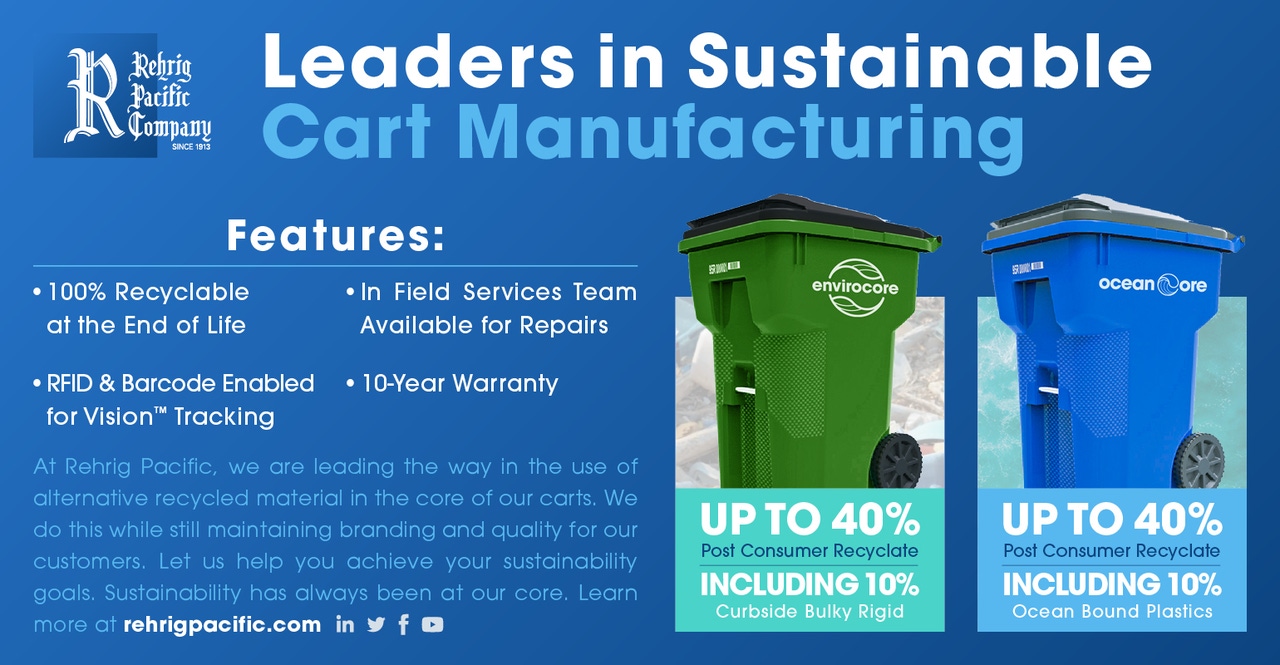The Big Idea Behind Sustainable Smart Carts
October 13, 2021

Sponsored Content
As a manufacturing company that supplies plastic products to the Waste & Recycling industry, Rehrig Pacific knows that everything we make can have a significant impact on the global environment. We are continuously asking ourselves not only, “How can we close the loop on our manufacturing processes?” but, “How can we help our customers close the loop on theirs?” We started this process decades ago, knowing that collaborating with our customers could create more sustainable carts.
Rehrig Pacific first entered the waste and recycling arena in 1984 when we developed the three-bin separation system for recycling. These bins established a standard for our customers and households lasting for over two decades. As the waste collection and management industry evolved, Rehrig Pacific developed additional products to handle these new challenges. In early 1990, we began to incorporate recycled material into these new roll-out carts and started to include post-consumer content in 2001.
We wanted to ensure the incorporation of recycled content would not come at the expense of durability. Developing a product that seems to be more sustainable on the surface by using high amounts of recycled content, but only lasts half as long is not sustainable. We then developed a patented co-injection technology that allows recycled content to be injected into the core of the cart. This enables up to 40% of the product to be manufactured using recycled content while also offering a range of different colors to suit the customer’s requirements.
We have also been able to use sources of material that are notoriously difficult to recycle such as large bulky rigid plastics, car seats, caps and labels, which are a by-product of the PET recycling industry, and even flexible film. Our EnviroCore roll-out carts consist of up to 40% post-consumer plastic, of which 10% is bulky rigid plastic. The 10% that we can use compares to other manufacturers that typically include between 2% and 5%.
Recent developments have allowed us to broaden the sourcing of recycled content. Through close collaboration with several partners, we now can incorporate ocean-bound plastic (plastic collected within 50km of the shoreline in communities that lack waste collection and management systems) into our carts. Our OceanCore rollout carts contain up to 10% ocean-bound material and an additional 30% recycled plastic from other sources for a total of 40%.
The key to manufacturing more sustainable products is not just the materials used, but to keep them in service as long as possible. This is why Rehrig Pacific cleans and repairs carts so they can continue to add value to the end-users and markets that they serve. This responsibility even extends to end of life; that’s why 100% of our core plastic products can be recycled when they can no longer be used. Through our buy-back program, we offer to recover as many of our products as possible so they can be recycled back into new products, turning waste into valuable resources.
Lost and stolen carts also create a waste of resources, money, and time. By equipping our carts with RFID tags that correspond to a unique barcode and serial number, our customers can accurately track routes and confirm pick-ups, creating a more efficient collection operation. These smart assets are helping our customers to run their businesses more sustainably resulting in fewer trucks on the road and fewer emissions into the atmosphere.
There are many ways towards creating a more sustainable product or solution, including manufacturing processes, raw materials, and most recently through developing technologies. But we need to think bigger if we want to make a real difference. Sustainability strategies are continuously being developed and implemented and updated. Many of these strategies are tackling very similar challenges which present a tremendous opportunity for collaboration. Building partnerships between supply chain companies and waste and recycling companies will be critical in finding real solutions. Along with helping to educate consumers and residents as to the part that they play to ensuring a clean waste stream thereby allowing us to use these valuable resources again and again.
Working together with other like-minded partners that share a similar perspective on a more sustainable and resilient future creates a chance to develop mutually beneficial solutions that are not only good for the bottom line but also the planet.
You May Also Like


